Goalie Pads Then and Now: A Look at the New Pad Restrictions 31
Goaltending through the years has been an ever-evolving science and trade, combining modern anatomical science with old fashioned grit. Goaltending we see today looks nothing like its bare-faced predecessor. The first goalies weren’t even allowed to go down on both knees to make a save, much less try the groin-busting splits of the Hybrid Butterfly. Pads have changed dramatically in the last several decades, almost too dramatically, as so the NHL has once again implemented new rules in the 2013-14 season to limit the size/shape of netminders’ equipment. Before we go on a walk down memory lane to the yesteryears of Jaques Plante and Gump Worsley, let’s have a look at the anatomy of goalie pads.
Goalie Pad 101:
It’s hard to think of something that hasn’t been improved by technology. Heck, these days you can even repel rats electronically thanks to modern science. The modern goalie leg pad has been modified from the old strap-on pillows to a technological masterpiece of puck-stopping engineering. Mainly, the Knee Stacks, or “Landing Gear,” that allow a goalie to go down on their knees without injuring them, and also allow the rectangular block of the pad to lie flush to the ice, preventing anything from sliding under it (unless you’re Marc-Andre Fleury…) are the biggest improvement.

As the “Butterfly” style improved, the desire to close off the area between the legs (the Five Hole) was remedied by what pad manufacturers call the “Thigh Rise.” Thigh Rise describes how many extra inches above the top of the knee that are added for extra closure when a goalie goes down in the butterfly. Pads are measured from floor to knee, so let’s say you wear a 34” pad, and then want an extra 3 inches of thigh rise, your pads would be labeled 34+3. Thigh Rise offers no extra protection, and removing it does not add any extra risk of injury, but we’ll touch on that later. Adding the thigh rise isn’t enough for most goalies, so to get it to curve inward and create a seal with the other pad a “Break” is added. Some pads have a Break under the knee as well, for added flexibility.

In the olden days of flat wooden sticks, most shots rarely rose above the waist level, and goalies could generally get away with not wearing a mask and having limited chest protection. The modern player is a genetically amped athlete, armed with carbon-fiber curved-blade sticks capable of placing a 100mph shot anywhere they want. Naturally, as shooters got stronger and more accurate, the goalie had to compensate. In 1928, Bruins Goalie Tiny Thompson (below) doesn’t even have a blocker, wears a modified baseball mitt, and looks to only have the most minimal of padding on his chest. Read the rest of this entry →



